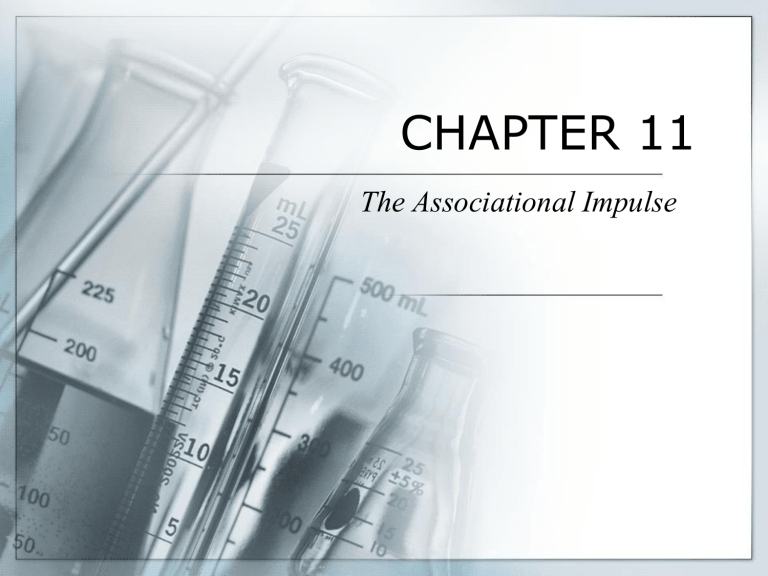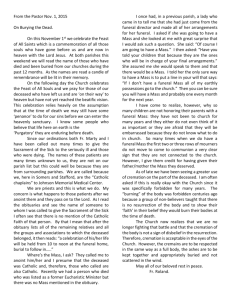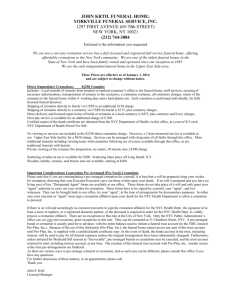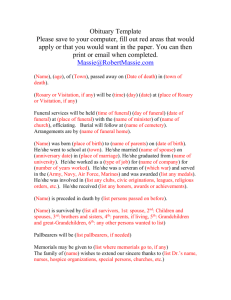chapter 11 - Introduction To Mortuary Sciences

CHAPTER 11
The Associational Impulse
Introduction
Associational Activity:
The gathering together and organizing of significant numbers of people around a limited set of interests and objectives.
Problems and Growth
It is the problems of the formal organization of funeral directors into various limited-objective types of associations, growth, prosperity, issues and changing forms and functions that gave the modern funeral director his form, but not without bumps and bruises along the way.
Background
Occupational Organizations
A creation of the 19th century.
Purpose of the trade organization was to define and help attain the interests of the businessmen.
Professional Associations sought to:
Formulate standards
Control membership and enforce an inspectional system
Ensure clienteles of high personal character and good moral standards of members.
Background
The Funeral establishments themselves were often patterned after guilds:
The Master
Journeyman
Apprentice
This was the most common internal relationship found in the industry in the 19 th Century.
To assist in attaining their needs, two instruments have been implemented:
Use of educational prerequisites and training institutions
The development of regulatory processes “police powers.”
The Sanitary Report
Sociocultural Movements:
The General Health Movement
Launched in 1850 by the “Report of the Massachusetts Sanitary
Commission
The report recommended
a sanitary police
state and local health departments
collection and analysis of vital statistics
In 1878 Congress established a National Board of Health.
Cremation in America
The Cremation movement:
Between 1881 and 1885 a number of cremation societies were organized and were entirely educational.
They had very little success.
In 1884 there was one crematory in the entire country.
***
Between 1876 and 1884 there were 41 cremations in America.
In the next 5 years there were 731.
The total number of cremations for the 5 years preceding 1894 was
2,898
Cremation in America
The Cremation movement:
“Flame Burial” was later accepted as a legitimate form of burial.
In San Francisco, the Cremation Society was originated by a group of German “Freethinkers.”
Cremation began to be more widely accepted and written about during the period between 1884 to 1889.(61 pieces of literature were written.)
But, by the 1904-1908 period the enamorment of cremation had dwindled. (very little info on cremation being written, dropped to 4 pieces written.)
Cremation in America
The Cremation movement:
In 1913 the initial meeting of the Cremation Association of
America met in Detroit. Those in attendance were the owners and operators of the 40 and Some odd crematories in operation at the time.
Hugo Erickson was elected the first president of the C.A.A.
His first remarks to his fledgling organization emphasized reform:
“Every Cremationist must be a missionary for the cause, and embrace every suitable occasion to spread its gospel, the glad tidings of a more Sanitary and more aesthetic method of disposing of air beloved dead.”
19th Century Associational
Development Among F.D.’s
Origins and early developments
Undertakers Mutual Protective Association of Philadelphia.
They were the first formal organization of undertakers formed in
January 1864.
Their purpose- the held a “black book” of delinquent customers.
Chicago Undertaker Association.
Established in 1868 for mutual protection, dispensing information and setting preliminary standards for operation of their trade.
National Funeral Directors Association
Allen Durfee was a Grand Rapids, MI undertaker.
He organized the first state association meeting in the country.
He was the “Father” of the NFDA.
He was the first NFDA President.
Michigan Funeral Directors Association
1st state to have an association
The first convention was held in Jackson, MI on January
14, 1880
Development of the NFDA
Founded in 1882
Significant events of the 1st convention
established that it should function as a parent organization for state associations.
Named itself the National Funeral Directors Association of the
United States (later shortened to NFDA).
Decided that merchandise and paraphernalia would be an integral part of the national meetings.
241 people were in attendance
“The desire for a more rapid educational improvement, led me to believe that through meetings and associations much good might be accomplished, which could not be obtained in any other way.”
Development of the NFDA
3 Significant events took place at the 1 st National Convention:
3 delegates from each State would be given the opportunity to vote and have u voice in the National arena.
To name the organization “the Funeral Directors National
Association of The United States:” (later the NFDA)
The forging of a close relationship manifested between the national Convention and the manufacturers of mortuary goods.
Early Leadership
Characteristics of early leadership
fairly well-to-do
fairly well-educated
middle-class
Most of the Funeral Directors of this time were self-made men, that worked their way into the trade not Just merely succeed their fathers.
Code of Ethics
Code of Ethics
Created to develop a sense of inner-cohesion or colleagueship among funeral directors.
Character and occupational morality
Necessity of obeying the law
Maintaining a high standard of conduct and advertising
Advertising in “daily prints” (papers) was prohibited
Why do you think they prohibited the printing of advertising in the papers?
Communication within the trade
Because of the rapid growth of the profession, communication with the trade was very important for the Funeral Director.
Communication Avenues
Drummers/Salesmen
Trade papers
Trade magazines
Growth, Problems, and Change
Relationships with Funeral Directors associations and manufacturers and their associations flourished.
Railways and health agencies became involved in matters of transportation.
There were no regulations so they made rules including the body had to be embalmed, could not have an infectious disease, and required permits.
What good do you think the regulations did?
Public Health Agencies
Funeral directors gained professional recognition for their work in embalming by the rules and regulations.
Mortuary Education
Changed from about 3 days in length to 3 months in length.
Communication was still a problem.
Professionalism
Professionalism
It was growing as a professional and was becoming more a respectable occupation.
Traces of Professionalism at the Turn of the Century
The first state to require licensure of embalmers in 1894 was
Virginia.
Trade vs. Profession
Do you think we are a trade or a profession?
What are characteristics of each?
Reference a Mortuary Law textbook for a list of the qualifications of a professional according to the Labor
Department.
Traces of Professionalism
Problems faced the aspiring profession of funeral directing
Embalming Procedures
Techniques and fluids
Tools and Instruments
Universal definition of what constituted proper training to enter the occupation
W hat do you think constitutes "proper training” to enter this industry?
Traces of Professionalism
Probably the most difficult problem still facing the funeral director at the turn at the century was the all-encompassing question or professionalism itself.
How far should the effort to professionalize the group be carried?
Communication within the occupation was growing although somewhat of a problem.



